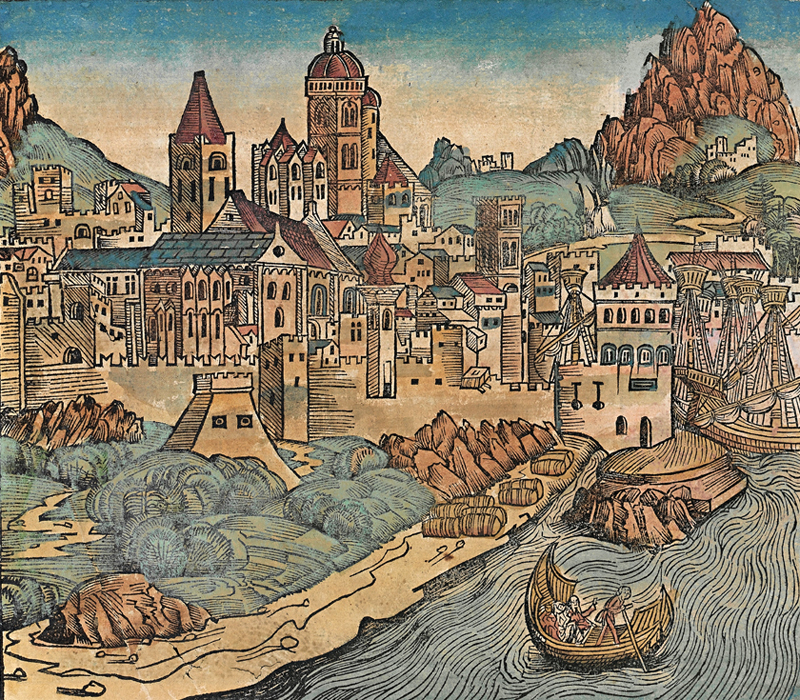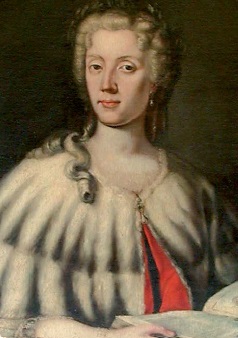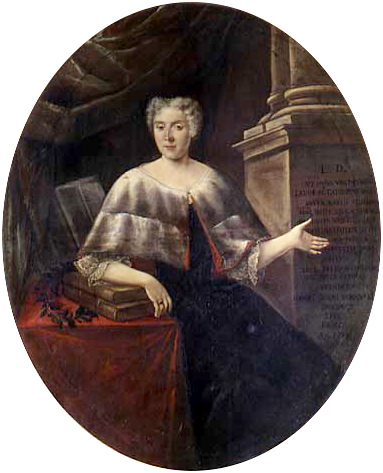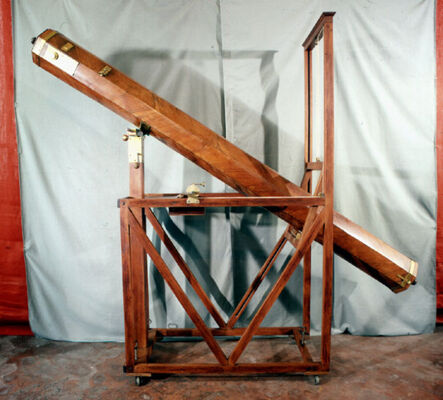
Category of Astronomical Heritage: tangible immovable
La Specola, Bologna Observatory, Italy

Description
Geographical position
Museo della Specola, old Bologna Observatory, Via Zamboni, 33, 40126 Bologna BO, Italy
1. National Institute for Astrophysics (INAF) - Astrophysics and Space Science Observatory of Bologna, Via Piero Gobetti, 93/3, 40129 Bologna BO, Italy
2. Loiano Astronomical Park, 37 km from Bologna, managed by INAF
3. Osservatorio Astronomico "Fabio Muzzi Giovagnoni", Piazzale Mario Jacchia, 1, 40136 Bologna BO, Italy
4. INAF- Istituto di Radioastronomia - Stazione di Medicina, Via Fiorentina, 3513, 40059 Medicina BO, Italy (44°31’15’’ N, 11°38’49’’ E)
5. Osservatorio Astronomico Felsina, Casalecchio di Reno (IAU code 205), Via Varsellane, loc. Monte San Pietro, 40100 Bologna.
Location
Latitude 44°29’48.08’’ N, Longitude 11°21’08.89’’ E, Elevation ...m above mean sea level.
IAU observatory code
281
Description of (scientific/cultural/natural) heritage

Fig. 1. Nicolaus Copernicus (1473--1543), Town Hall in Thorn (Wikipedia)
The northern Italian metropolis of Bologna is the oldest university in Europe (1088). Especially in the 13th century it gained an excellent reputation as a law school. After having studied in Cracow, Nicolaus Copernicus (1473--1543) enrolled in Bologna in order to study canon law and civil law, 1496 to 1500. The matriculation of the "Natio Germanorum", the registration fee of nine grossetti is documented with the text: "D[ominus]. Nicolaus Kopperlingk de Thorn. Gross [etos] novem" (1497). In Bologna, which at that time was an important center of the Renaissance and Humanism, Copernicus met Domenico Maria de Novara (1454--1504), eminent professor for astronomy, and cooperated with him.

Fig. 2a. Giovanni Domenico Cassini (1625--1712) (Wikipedia)

Fig. 2b. Meridian line in the Basilica of San Petronio (1655), (Wikipedia, CC3, CEphoto Uwe Aranas)
The next famous astronomer was Giovanni Domenico Cassini (1625--1712), who accepted the call to Bologna as professor for astronomy and mathematics in 1650. He preferred Tycho Brahe’s e helio-geocentric model, while hesitating to adopt Copernicus’ heliocentric model. In 1655, Cassini set up his famous 66.7m still existing long meridian line in the Basilica of San Petronio for his solar observations to determine the time and the date, and to check the Gregorian Calendar. Using the long-focal length telescopes of Eustachio Divini (1610--1685) from Rome and Giuseppe Campani (1635--1715) in 1665, he could determine -- with the help of the great red spot on Jupiter -- its own rotation. In addition, he examined the surfaces of the planets in more detail, and determined the rotation times of Venus and Mars. By observing the orbit of Jupiter’s moon Io, he could derive the longitude, a first important step for navigation. In 1669, Cassini was appointed to the newly founded Académie Royale des Sciences and director of Paris Observatory.

Fig. 3. Count Luigi Ferdinando Marsili (1658--1730), (Wikipedia)
Some decades later, Count Luigi Ferdinando Marsili (1658--1730) made his instruments available to interested young researchers: he had built an observatory on the top of his palace, the "Specola Marsiliana", where observations were carried out until 1709.
When Marsili wanted to move his activities to another place, the Senate of Bologna offered him the construction of an observatory tower with a laboratory, library and the assumption of some professors’ salaries. In his will he bequeathed his library and a rich collection of instruments, minerals and ancient works of art to the city of Bologna, which later made them available to scholars in the Palazzo Poggi.

Fig. 4. Tower of "La Specola" Observatory (1712) (© Paolo Monti, Servizio fotografico Bologna (1974), BEIC 6348948)
In 1712, the contract for the establishment of the "Accademia delle Scienze dell’Istituto di Bologna" at Palazzo Poggi (built in 1560) was signed. The tower of the old "La Specola" Observatory, a reminder of the tradition of astronomical research, started in 1713 by the architect Giuseppe Antonio Torri (1655--1713) in late-Baroque style, and completed in 1726 by Carlo Francesco Dotti (1670--1759). It was built on top of Palazzo Poggi.

Fig. 5. Eustachio Manfredi (1674--1739), mathematician, astronomer and poet, engraving by Francesco Rosaspina (1762--1841), 1792 (Wikipedia)
The planning as well as the later management was entrusted to Eustachio Manfredi (1674--1739), who had already looked after the Specola Marsiliana as an observer. In 1756, the "Aula Magna", the original library of the Institute of Science and the first public library in Bologna, was added to the Palazzo Poggi. The main rooms were:
1st floor: the Meridian Room "Sala della Meridiana" (1727) with an adjoining chamber -- the astronomer’s study and assistant’s working rooms (today: Horn d’Arturo telescope).
2nd floor: living quarters of the astronomer
3rd floor (the present-day "Globe Room": instruments like the brass parallactic telescope, donated by Benedict XIV (1675--1758) in 1752, the reflecting telescope donated by Cardinal Davia and two quadrants, one frome Marsili Observatory and one donated by Cardinal Albani in 1728
4th floor: a helical staircase leads to the "Turret Room" with the quadrant donated by Davia and all the accessories for the long telescopes, cycloidal clock of Isaac Thuret (died 1706) - lost. The terrace of the Specola offers a splendid view of the city.
The main instrument was a large mural quadrant. With it, the geographical latitude of the observatory could be determined precisely with an error of only 0.8’’. Manfredi also tried in vain to measure the parallaxes of two bright stars in order to prove Copernicus’ world system.

Fig. 6. Eustachio Zanotti (1709--1782) (Wikipedia)
For his successor Eustachio Zanotti (1709--1782) three English precision instruments were acquired, made by the successor to Graham, Jonathan Sisson (1690?--1747) of London (1739): moveable astronomical quadrant, large mural quadrant, transit telescope (length of telescope 85cm). In 1742 the instruments were finally installed. Zanotti successfully carried out the measurements for his star catalogue (1750).
Petronio Matteucci (1717--1800) purchased in 1787 a parallactic achromatic telescope, a long telescope and a reflecting telescope from Dollond, a wide-field telescope by Gilbert, and a sophisticated compensated pendulum clock by Ellicott.
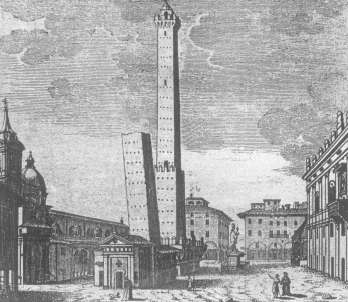
Fig. 7a. "Two Towers" in Bologna: Garisenda (48m) and Asinelli (97m) (Pio Panfili, 1767, Wikipedia)

Fig. 7b. "Two Towers" in Bologna: Garisenda (48m) and Asinelli (97m) (Wikipedia, CC3, Blofeld of SPECTRE)
Giovan Battista Guglielmini (1763--1817) tried to measure the east deviation during the Free Fall in 1791 using the tower degli Asinelli, published in 1792. His ideas formed the basis on which Johann Friedrich Benzenberg (1802) continued successfully.
Michele Rajna (1854--1920), director from 1903 to 1920, was interested in geodetic astronomy, geomagnetism and astronomical and meteorological observations.
Guido Horn d’Arturo (1879--1967), since 1912 assistant at the University Observatory in Bologna under Michele Rajna, director since 1921, worked in the field of positional astronomy as well as cosmology; he dealt with the nature of comets, solar observations and variable stars. He observed the total solar eclipse on January 14, 1926 in Somalia and on June 19, 1936 in the Peloponnese. He equipped the observatory with a Zeiss reflector with a diameter of 60cm. Horn d’Arturo constructed telescopes whose mirrors were composed of individual segments: Next to the Sala della Meridiana of the Specula is the tiled telescope designed by Guido Horn d’Arturo, and built in 1952: this invention by Horn is now considered a forerunner of modern multi-mirror telescopes.

Fig. 8. 60-cm-Zeiss-Reflector (1936), Loiano (Wikipedia)
In 1936, he initiated a new observation station in Loiano at around 800m elevation, which offered better observation conditions than in Bologna. He bought a Zeiss reflector with a diameter of 60cm.
History

Fig. 9a. Mural Semicircle, two movable astronomical Quadrants,
made by Domenico Lusverg of Rome (1702/04), (Specola Museum of Astronomy)

Fig. 9b. Mural quadrant, Transit telescope, moveable astronomical quadrant, made by Jonathan Sisson of London (1739), (Specola Museum of Astronomy)

Fig. 9c. Arab astrolabe attributed to Ibn Baso (~1280), (Specola Museum of Astronomy)

Fig. 9d. Mediterranean nautical map by Giulio Petrucci (Pisa, 1571), (Specola Museum of Astronomy)
Instruments
- Astrolabes
Flemish astrolabe from 1565 by Gualterus Arsenius
Arab astrolabe attributed to Ibn Baso (~1280) - Armillary spheres
Armillary Sphere, Domenico Lusverg (18th century)
Copernican Armillary Sphere (18th century) - Terrestrial and Celestial Globes
Terrestrial and Celestial Globe, Blaeuw, Willem Janszoon (17th century)
Celestial Globe, Gerhard & Leonard Valk, Silvestro Giannotti (18th century)
Terrestrial and Celestial Globe, Giovanni Maria Cassini (18th century)
Terrestrial and Celestial Globe, John Senex (18th century)
Celestial Globe, Ernst Schotte & Co (19th century) - Nautical instruments
Mediterranean nautical map by Giulio Petrucci (Pisa, 1571)
Mediterranean nautical map by Banet Panadès (Palermo, 1556) - Surveying instruments
Theodolite, Franciscus Merighius (17th century)
Theodolite, Ertel & Sohn (19th century)
Gravimeter, Paul Carré (17th century)
Gravimeter, Pierre Sevin (17th century)
Goniometer, Etienne Lenoir (18th century)
Goniometer, Jesse Ramsden (18th century)
Reflecting Circle, Etienne Lenoir (18th century) - Magnetic and Seismological instruments
Declinatorium, Georg Friedrich Brander (18th century)
Declinatorium, Giovanni Lodovico Quadri (18th century)
Seismogaph (18th century), Seismoscope (19th century) - Meteorological instruments
Thermometers, Mercury and Aneroid Barometers (19th century)
Heliograph used to measure solar radiation
Anemoscope (wind direction)
Hair Hygrometer (19th century)
Psychrometer (to determine the humidity)
Pluviometer (20th century)
Pyroheliometer
Calorimeter
Chart Recorder (20th century) - Mural Quadrant, made by Domenico Lusverg (18th century)
- Movable astronomical Quadrant, Sante Menini (18th century)
- Mural Semicircle and movable astronomical Quadrant,
made by Domenico Lusverg (1669--1744) of Rome (1702-1704)
installed in the Sundial Room - South-West area - Wire Micrometer (18th century)
- Octant, Peter Dollond (18th century)
- Sextant (19th century)
- English, French and even Bolognese Clocks -- clock donated by cardinal Giovanni Antonio Davia (1660--1740)
Pendulum clock, Daniel Quare (17th century)
Pendulum clock, John Ellicott (18th century)
Marine chronometer, Charles Frodsham, Parkinson & Frodsham (19th century) - Meridian line, Ercole Lelli (18th century)
- Italian Telescopes:
- Objective Lenses, Geminiano Montanari, Marco Antonio Cellio, Giuseppe Campani (17th century)
- 1.5-ft telescope attributed to Giuseppe Campani (1636--1715) of Rome,
- 10.5-ft telescope by G. Campani of Rome (c. 1700),
- 22-ft telescope by G. Campani of Rome (c. 1714), octagonal cypress tube, given by cardinal Sebastiano Antonio Tanari
- 33-ft object lens by G. Campani of Rome (c. 1714)
- 14-foot telescope by Marco Antonio Cellio of Rome (1685)
- Newtonian Reflecting telescope, donated by cardinal Davia in 1725
- Reflecting telescope, Giovanni Battista Amici (1813)
- Refracting Telescope, Officina Liuzzi, Bologna (20th century)
- English and German Instruments:
- Moveable astronomical quadrant, made by Jonathan Sisson (1690?--1747), successor to Graham, of London (1739)
- Large Mural Quadrant (radius 172cm), made by Jonathan Sisson of London (1739)
- Transit telescope (length of telescope 85cm), made by Jonathan Sisson of London (1739) and James Mann --
In 1742 the instruments were finally installed in the Sundial room: South-East area - Gregory telescope, Jonathan Sisson of London (18th century)
- Gregory telescope, Peter Dollond (18th century)
- Parallactic telescope, Peter Dollond (18th century)
- Telescope in universal mount by George Adams (London, ~1760-70)
- Refracting Telescope (focal length 314cm = 8 foot), George Adams (1787)
- Multiplication Circle, Reichenbach, Utzschneider & Liebherr of Munich (1804-1814)
- Transit telescope, Reichenbach, Utzschneider & Liebherr of Munich (1804-1814)
- Meridian circle, Ertel & Sohn of Munich (1847)
- 16-cm-Refracting Telescope (focal length 260cm), Carl August von Steinheil of Munich (1870)
- Coordinate Measuring Machine, The Gaertner Scientific Corporation (20th century)
- Tiled telescope, designed by Guido Horn d’Arturo (1879--1967) and built in 1952, a forerunner of modern multi-mirror telescopes.
- 60-cm-Reflector, Carl Zeiss of Jena (1936)
- Photometer (Schnellphotometer II), Carl Zeiss of Jena (20th century) - allows to measure the variations in density of a photographic plate, to obtain the profiles of the spectral lines or the magnitudes of celestial objects.
- Model of the Radiotelescope

Fig. 9e. Meridian line, between the zodiac sign of Gemini and that of Scorpion, with the image of the solar disk (Specola Museum of Astronomy)

Fig. 9f. Telescope in universal mount by George Adams (London, 1760/70), (Specola Museum of Astronomy)
Directors
- Giovanni Antonio Magini (1555--1617),
- Giovanni Domenico Cassini (1625--1712), 1650 to 1669
- ....
- Eustachio Zanotti (1709--1782), 1739 to 1782
- Petronio Matteucci (1717--1800), 1782 to 1800
- Giovan Battista Guglielmini (1763--1817), 1794 to 1817
- ....
- Michele Rajna (1854--1920), 1903 to 1920
- Guido Horn d’Arturo (1879--1967), 1921 to 1938, 1945 to 1954
- Francesco Zagar (1900--1976), 1938 to 1945
- ....
State of preservation
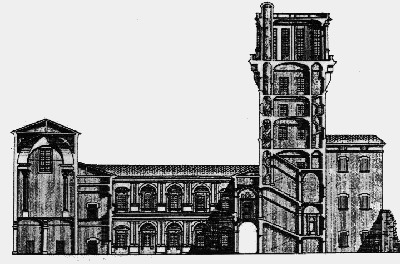
Fig. 10. "La Specola" Observatory (Bolletti 1751)
"La Specola" Observatory in Palazzo Poggi, the first university observatory in Italy, is well preserved.
On the occasion of the 2017 European Heritage Days, the Superintendence of Archeology, Fine Arts and Landscape of Bologna and the University Museum System of the University of Bologna promoted a public meeting about the restoration work on the Specola di Bologna, affected by the earthquake of five years ago.
Comparison with related/similar sites
Baroque tower observatories like Specola - Bologna Observatory (1712) can be found in different places around the world:
Clementinum Prague (1722), Zwehrenturm in Kassel (1710), Specola - Bologna Observatory (1712), Old Vienna Academy Observatory -- tower on the top (1755), Osservatorio Astronomico di Brera of the Jesuits in Milano (1762), Padova (Padua) Observatory (1767), Mannheim Observatory (1772), Bogotá Observatory, Columbia (1803).
Threats or potential threats
no threats
Present use
Since 1979 "La Specola" Observatory in Palazzo Poggi houses a remarkable museum "Museo della Specola" for the history of astronomy of the University of Bologna with a rich collection of instruments (astrolabes, armillary spheres, globes, maps, quadrants, telescopes, clocks, nautical and surveying instruments) offer a broad overview concerning history of astronomy. In 1742, the artist Ercole Lelli (1702--1766) created the brass sundial, which was used until the mid-twentieth century to signal noon to citizens every day.
Astronomical relevance today
Modern research (and public outreach) is done in different places:
1. Dipartimento di Astronomia, Università di Bologna, National Institute for Astrophysics - Astrophysics and Space Science Observatory of Bologna, Via Piero Gobetti, 93/3, 40129 Bologna BO, Italy

Fig. 11. 152-cm-Cassini-Telescope (1976), Loiano (Wikipedia)
2. Loiano Astronomical Park, 37 km from Bologna, managed by INAF: 60-cm-Zeiss-Reflector (1936) and 152-cm-Cassini Telescope (1976) - second largest in Italy

Fig. 12. Osservatorio Astronomico "Fabio Muzzi Giovagnoni"
3. Osservatorio Astronomico "Fabio Muzzi Giovagnoni", Piazzale Mario Jacchia, 1, 40136 Bologna BO, Italy

Fig. 13. Northern-Cross-Radio-Telescope, Medicina Radio Observatory (Wikipedia, Paolo Monti)
4. Istituto di Radioastronomia di Bologna (INAF) operates:
- Stazione di Medicina, Via Fiorentina, 3513, 40059 Medicina BO, Emilia-Romagna, Italy: 32-m-parabolic antenna for observing between 1.4 and 23 GHz and 564-m by 640-m multi-element Northern Cross cylindrical-parabolic transit radio telescope for observing at 408 MHz (1964)
- Noto Radio Observatory in Noto, Sicily
- Sardinia Radio Telescope (SRT) in Sardinia.
5. Osservatorio Astronomico Felsina, Casalecchio di Reno (IAU code 205), Via Varsellane, loc. Monte San Pietro, 40100 Bologna -
located in the heart of the Bolognese Apennines (651m), not much affected by the light pollution, and due to the "Associazione Astrofili Bolognesi" (AAB), founded in 1967, it is open to the public.
References
Bibliography (books and published articles)
- Baiada, E.; B├▓noli, Fabrizio & A. Braccesi: Museo della Specola. Bologna: Bologna University Press 1995.
- Benzenberg, Johann Friedrich: Versuche über die Umdrehung der Erde. Düsseldorf 1845.
- Bolletti, Giuseppe Gaetano: Dell’origine e de’ progressi dell’Instituto delle Scienze di Bologna. Bologna: Stamperia di Lelio dalla Volpe 1751.
- B├▓noli, Fabrizio & F. Poppi: Astronomy in Bologna in the 19th century. In: History of Physics and Astronomy in Italy in the 19th and 20th centuries. Milano: Soc. It. toria della Fisica e dell’Astronomia 2004, p. 83-90.
- B├▓noli, Fabrizio: 70 anni allo specchio: 1936--2006. Anniversario dell’inaugurazione del telescopio Zeiss da 60cm e della Stazione astronomica di Loiano del 15 novembre 1936, 2006.
- B├▓noli, Fabrizio: 350 anni della grande meridiana di Cassini in San Petronio. In: Giornale di Astronomia 1 (marzo 2006), p. 53-68.
- B├▓noli, Fabrizio: Bologna - Il Museo della Specola (English). Bologna: Editrice Compositori 2007 (64 pages).
- B├▓noli, Fabrizio: Eustachio Manfredi. In: Biographical Encyclopedia of Astronomers. New York: Springer 2007, p. 733-735.
- B├▓noli, Fabrizio: Eustachio Zanotti. In: Biographical Encyclopedia of Astronomers. New York: Springer 2007, p. 1256-1257.
- B├▓noli, Fabrizio: Guido Horn d’Arturo. In: Biographical Encyclopedia of Astronomers. New York: Springer 2007, p. 525-526.
- B├▓noli, Fabrizio: Matteucci, Petronio. In: Dizionario Biografico degli Italiani, Vol. 72 (2008).
- B├▓noli, Fabrizio: Il Museo della Specola del Dipartimento di Astronomia e del Sistema Museale d’Ateneo dell’Alma Mater Studiorum. In: Annali di storia delle Universit├á italiane, vol. 12. Bologna: Clueb 2008, p. 489-497.
- Bònoli, Fabrizio: Cassini e la tradizione astronomica galileiana a Bologna. In: Galileo e la scuola galileiana nelle Università del Seicento. Bologna: Clueb 2011, p. 171-188.
- B├▓noli, Fabrizio; Fusi, Pecci F. & F. Poppi: Dall’Osservatorio astronomico universitario all’Osservatorio astronomico di Bologna: 1957-1985. In: Da Bologna allo spazio. Avvio, promozione e sviluppo della ricerca astrofisica. Bologna: Bononia University Press 2011, p. 71-90.
- B├▓noli, Fabrizio: Horn d’Arturo, Guido. In: Thomas Hockey et al. (ed.): Biographical Encyclopedia of Astronomers. New York: Springer 2014.
- Broucek, Peter: Marsili, Luigi Ferdinando Conte di. In: Neue Deutsche Biographie (NDB), Vol. 16. Berlin: Duncker & Humblot 1990, p. 259 f.
- Canadelli, Elena: Rajna, Michele. In: Romanelli, Raffaele (ed.): Dizionario Biografico degli Italiani (DBI), Vol. 86: Querenghi-Rensi. Rome: Istituto della Enciclopedia Italiana 2016.
- Chalmers, Alexander: Manfredi (Eustachio). In: The General Biographical Dictionary: A New Edition, Vol. 21. London: Nicirols & Son 1815, p. 235.
- Chinnici, Illeana; Mandrino, A. & Fabrizio Bonoli: Historical Archives in Italian Astronomical Observatories: the "Specola 2000" Project. In: Journal of Astronomical History and Heritage 9, part 2 (2006), p. 200-202.
- Feingold, Mordechai & Victor Navarro-Brotons (ed.): Universities and Science in the Early Modern Period. New York: Springer 2006.
- Gualandi, Andrea & Fabrizio Bonoli: Eustachio Manfredi e la prima conferma osservativa della teoria dell’aberrazione annua della luce. Bologna: Dipartimento di Astronomia, Universit├á degli Studi di Bologna 2004.
- Gualandi, Andrea & Fabrizio Bonoli: The search for stellar parallax and the discovery of the aberration of light: the observational proofs of the Earth’s revolution, Eustachio Manfredi and the ’Bologna case’. In: Journal for the History of Astronomy 40, part. 2 (2009), no. 139, p. 155-172.
- Heilbron, John L.: The Sun in the Church: Cathedrals as Solar Observatories. Cambridge: Harvard University Press 2001.
- Horn d’Arturo, Guido: Necrologia di Michele Rajna. In: Memorie della Societ├á Astronomica Italiana 1 (1920), S. 303-304.
- Poppi, F.; Bonoli, Fabrizio & Andrea Gualandi: A short history of two nineteenth-century German instruments at the Bologna Observatory: the 16-cm Steinheil refractor and the Ertel & Sohn meridian circle. In: Journal of Astronomical History and Heritage 11 (2008), n. 2, p. 157-166.
- Rodolico, Francesco: Marsili (or Marsigli), Luigi Ferdinando. In: Gillispie, Charles Coulston (ed.): Dictionary of Scientific Biography, Vol. 9: A.T. Macrobius -- K.F. Naumann. New York: Charles Scribner’s Sons 1974, p. 134-136.
- Rosati, Riccardo: Il complesso museale di Palazzo Poggi a Bologna. In: Nuova Museologia 43 (Novembre 2020), p. 14-17.
- Schmeidler, Felix: Nachruf Francesco Zagar. In: Mitteilungen der Astronomischen Gesellschaft 41 (1977), p. 5-6.
- Witt, Volker: Die historische Sternwarte "La Specola" in Bologna. In: Sterne und Weltraum 44 (2005), Nr. 1, S. 76-81.
Links to external sites
- Die historische Sternwarte "La Specola" in Bologna, Spektrum der Wissenschaft (30.11.2004).
- Museo della Specola, Bologna (SMA - Sistema Museale di Ateneo)
- Instruments in the Museo della Specola, Bologna
- Conti, Carla: Il restauro della Specola di Bologna, l’Osservatorio Astronomico della citt├á
- Giuseppe Antonio Torri (Wikipedia)
- Ercole Lelli was born on September 14, 1702 in Bologna
- Museum La Specola
- Loiano Astronomical Park
- Osservatorio Astronomico Felsina
Links to external on-line pictures
no information available
No multimedia content published
Currently there is no multimedia content published for this case study










